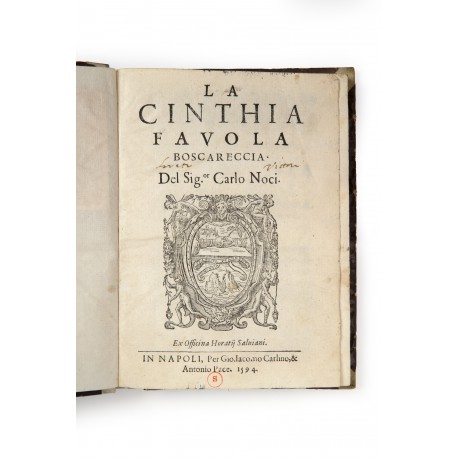 View larger
View larger
La Cinthia favola boscareccia del Sig.or Carlo Noci
- Subjects
- Literature, Italian - Drama - Early works to 1800
- Authors/Creators
- Noci, Carlo, fl. 1594-1602
- Printers/Publishers
- Carlino, Giovanni Giacomo, active 1579-1600
- Pace, Antonio
- Salviani, Orazio, active 1566-1594
Noci, Carlo
La Cinthia favola boscareccia del Sig.or Carlo Noci.
Naples, Giovanni Giacomo Carlino & Antonio Pace (‘Ex Officina Horatii Saluiani’), 1594
quarto (198 × 142 mm), (92) ff. signed π4 A–Y4 and paginated (8) 1–176. Printer’s device of G.G. Carlino on title-page;1 woodcut ornaments and initials.
provenance unread inscription on title-page — M. & L. Sordelli, exlibris with motto ‘Fatica senza fatica’, discreet red inkstamp S (within a circle) in lower margin of title-page — Christie’s, ‘Libri, autografi e stampe’, Rome, 27 November 2002, lot 232.
In very good state of preservation.
binding old vellum-backed boards.

First edition of a five-act pastoral drama in verse, dedicated by its author to Giambattista Caracciolo, Marchese di Brienza, and also by the poet Giovanni Battista Vitale da Foggia to Vincenzo Filingieri, who is reported here to be the model for the character of Dameta.2 Inspired by Tasso’s Aminta and by Guarini,3 Noci’s plot hinges on the eponymous heroine returning to Arcadia after an absence of four years disguised as a boy, to find her lover courting another nymph. It was the one of the direct sources of The Queenes Arcadia (1606) by Samuel Daniel.4
The play was performed successfully in Milan in 1596 and twice reprinted at Venice ‘presso la Compagnia Minima’, in 15965 and 1599, and at Naples, by Domenico Maccarano, in 1631. Noci subsequently published a volume of verse (Canzone di Carlo Noci all’illustriss.mo sig. don Francesco di Castro, Naples: G.G. Carlino, 1600) and in 1602 appeared the work for which he best-known, a rimario (index of rhymes) for the Divine Comedy.6
Fifteen copies of this first edition survive in Italian libraries (according to Edit 16, CNCE 23759), and elsewhere we trace these copies
● Berlin, Staatsbibliothek, Xq4684 ● Boston, Public Library, XG.594 .N67C ● Champaign-Urbana, University of Illinois, Italian plays 301 ● Chicago, University of Chicago, PQ4630.N5C6 15947 ● Cambridge, MA, Harvard University, *IC5.N6723.594c ● London, British Library, 82.k.28 ● Manchester, John Rylands Library, R47303 ● New Haven, Yale University, Hd22 483 ● Oxford, Taylor Institution Library, VET.ITAL.I.B.25
references Giovanni & Carlo Salvioli, Bibliografia universale del teatro drammatico italiano (Venice 1903), col. 764; Lione Allacci, Drammaturgia… accresciuta e continuata fino all’ anno mdcclv (reprint Turin 1961), col. 191; Pietro Manzi, La tipografia napoletana nel ’500: Annali di Orazio Salviani (Florence 1974), no. 195; Laura Cairo and Piccarda Quilici, Biblioteca teatrale dal ‘500 al ‘700: La raccolta della Biblioteca Casantense (Rome 1981), no. 887
1. Pietro Manzi, La tipografia napoletana nel ’500. Annali di Giovanni Giacomo Carlino (Florence 1975), tav. 1, fig. 2.
2. Monica Brindicci. Libri in scena: editoria e teatro a Napoli nel secolo xvii (Naples 2007), p.139 no. iv.
3. Clara Borrelli, Su Tasso e il tassismo tra Cinquecento e Ottocento (Naples 2001), chapter ii: ‘D’una assai vaga, e pura verginella. Presenze tassiane nella Cinthia di Carlo Noci’; Laura Riccò, Ben mille pastorali: l'itinerario dell'Ingegneri da Tasso a Guarini e oltre (Rome 2004), pp.67, 131, 154.
4. Jason Lawrence, ‘Who the devil taught thee so much Italian?’: Italian language learning and literary imitation in early modern England (Manchester 2005), p.103.
5. Copies of this edition – only – are described by Louise G. Clubb, Italian plays (1500–1700) in the Folger Library: a bibliography (Florence 1968), p.170 no. 630; and Beatrice Corrigan, Catalogue of Italian Plays, 1500–1700, in the library of the University of Toronto (Toronto 1961), p.68.
6. Rimario de tutte le disinenze della Comedia di Dante Alighieri (Naples: G.G. Carlino, 1602).
7. Mauda Bregoli Russo, Renaissance Italian theater: Joseph Regenstein Library of the University of Chicago (Florence 1984), p.125 no. 430.
8. Short-title catalogue of Italian books (London 1958), p.469.


